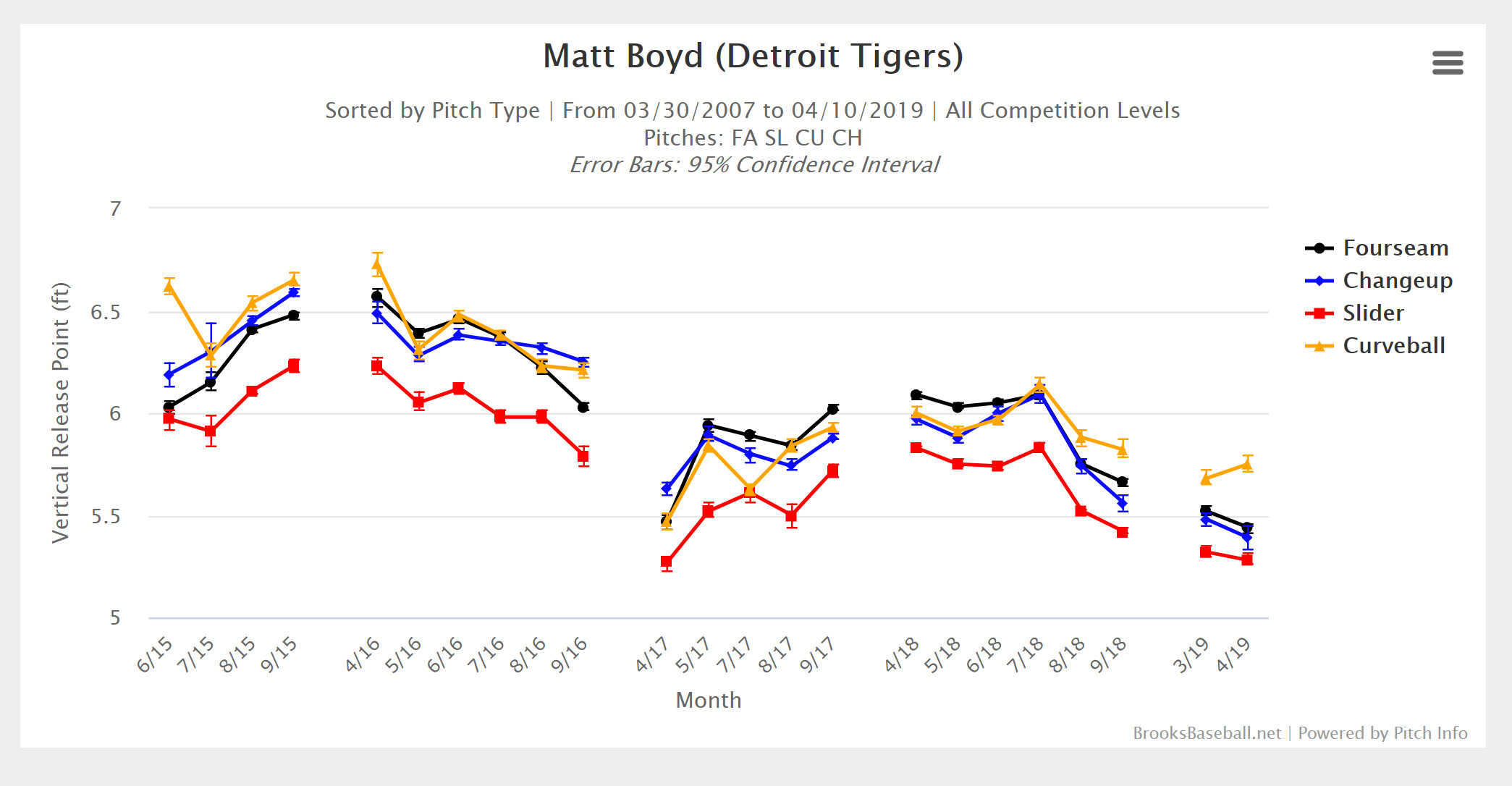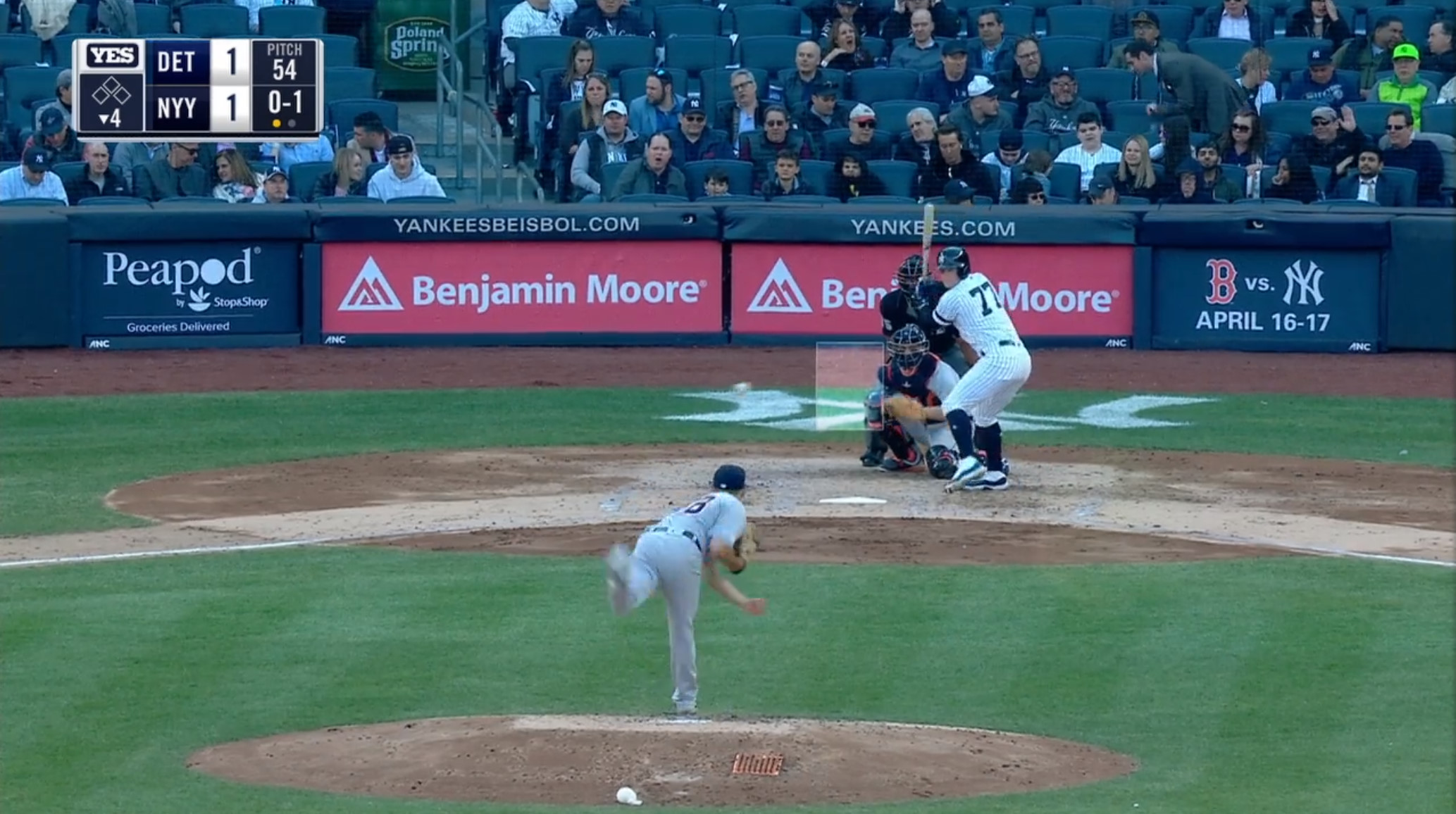Here Are a Few Things About Matthew Boyd
Matthew Boyd has been around for a bit. He was drafted by the Blue Jays in the sixth round of the 2013 Draft out of Oregon State University. He made the majors with the team but was traded to the Tigers at the 2015 trade deadline along with Daniel Norris and Jairo Labourt in exchange for David Price. As a prospect, he wasn’t too highly regarded. While he was a regular on Carson Cistulli’s Fringe Five column, he wasn’t highly ranked. Baseball America, for instance, included him in their organizational rankings only once (he was the 29th prospect in the Jays system after the 2014 season); he received sporadic mention at Baseball Prospectus.
After splitting time between the majors and Triple-A in 2016 and 2017, 2018 showed some promise for Boyd. His strikeout rate went up and his walk rate went down. His home run rate also went up and while overall he took a step forward as a decent rotation guy for the Tigers, there was room to improve. As my friend Brandon Day over at Bless You Boys noted, Boyd showed an extreme home/road split, which is one pitfall of being a flyball pitcher whose tendencies can be masked by playing in the pitcher-friendly Comerica Park. Boyd himself wasn’t satisfied either. He spent his offseason basically finding every way he could to improve himself. He lost 15 pounds, maintained his muscle mass, and even did DNA-based testing to find out what works and doesn’t work for his body.
And so far in 2019, Boyd has been a strikeout machine. In three starts, Boyd has racked up 40.3% strikeout rate, the second highest rate the majors behind Blake Snell. Yes, there’s the obligatory small sample size warning here. Boyd will likely not keep that rate up for the rest of the season. But looking at the changes he’s made and how the hitters have responded to them, there are reasons to believe that he could be taking the next step as a pitcher.
The first thing that I noticed is his release point, and how that has affected his pitches. Boyd has had a low three-quarter arm slot for most of his career. However, he showed up with an even lower one this season. For comparison, here’s 2018:

And here’s 2019:

It may not look like a huge difference. You might not see it on a first glance. If you don’t, here’s a big hint: on the 2018 screenshot, Boyd’s posture is slightly leaning towards his glove arm side. On his 2019 delivery, he’s slightly more upright. If you are still not convinced, here’s his vertical release point data courtesy of Brooks Baseball:

As you see, even in this early bit of this season, his release point on all of his pitches besides his curve has even gotten lower. And according to data from Statcast, Boyd’s fastball spin rate is up quite noticeably.
| Fastball Velocity | Fastball xOBA | Fastball Spin | |
|---|---|---|---|
| 2018 | 90.5 mph | .297 | 2,282 rpm |
| 2019 | 90.6 mph | .270 | 2,392 rpm |
The general wisdom is that the faster a pitch is, its spin rate correlates with it. His 2,392 rpm average spin rate ranks in the 82nd percentile in all of baseball, which is remarkable for a guy who’s averaging in low-90s with his heat. We don’t know if Boyd is doing anything else with his pitch release that’s making such a difference, but an arm slot change is a plausible theory. We’ve seen instances in the past where pitchers altered their arm slots and saw improvements in their spin rates. Some, like Jeremy Jeffress, took their performance to next level. Eno Sarris went as far as writing a post on who could improve their fastball spin rate by dropping their arm slot. Throwing a baseball is a fickle thing – applying a different sort of pressure with the finger upon release can affect the spin axis and rate.
Boyd’s fastball velocity is about the same and his slider may have lost a few ticks, but they have gotten better results in the three 2019 starts he has made. As for the fastball, the explanation could be simple – the better spin rate usually correlates with better results. When thrown high in the zone, it can have the “rising” effect where it ends up a few inches higher than fastballs of lower spin rates (we will talk more about that soon).
Speaking of his fastball and slider, we ought to talk about Boyd’s pitch locations. In 2018, here is how he used his fastball:

And his slider:

It’s pretty straightforward. In 2018, Boyd liked to use his fastball up and show a different eye level with his slider. These two were also his most used pitches, as they took up 79.9% of his 2018 arsenal.
Here’s how he located them so far in 2019. First, his fastball:

And his slider:

He took his two best pitches and has made his tendencies even more extreme so far this season. He’s throwing his fastballs higher and burying his sliders way, way lower. Also noteworthy is that he’s avoiding the middle part of the plate more than he did last year. He has also thrown his fastball and slider for a combined 89.4% of the time. While he hasn’t scrapped his curveball (8.4%) and changeup (2.2%) completely, he’s focusing more on his strength pitches. The more a pitcher believes in his pitches, the more he’s going to throw it. Boyd’s pitch usage certainly reflects that.
It’s worth noting that Boyd threw a sinker (as categorized by Brooks Baseball) in the past. In 2018, he threw it 287 times. The results weren’t pretty, as the hitters mashed it to the tune of a .302 BA and .524 SLG. So what did he do? Almost completely scrapped it completely. In three starts, he’s only thrown 11 of them, as opposed to 134 four-seamers.
I mentioned increased spin rate on his fastball earlier. Because his heater has a bit more life to it, it plays better in the higher part of the zone and can lead to swings-and-misses on a 91 mph fastball like this:

His slider isn’t the fastest one out there. No one’s going to confuse it with Noah Syndergaard’s 90 mph hard slider. However, it was his most effective pitch even before this season. Last year, Boyd’s slider had a 17.7 pitch value, which was by far his best of the arsenal. It had a 16.5% whiff rate. This season, albeit in small sample, it has a 24.5% whiff rate. There’s a lot that contributes to its effectiveness. Part of it may have to do with his slider itself being pretty good. Part of it is his spin-rich fastball, and how the way he locates that pitch gives a new look to the slider.
What jumps out to me is that Boyd tunnels both pitches really well. Here are two pitches to Clint Frazier in an at-bat on April 3. One of them is a fastball on the inside corner; the other is a slider that’s buried under the zone for a whiff. Take a guess which is which:


The first one is fastball and the second is slider. If you’re not convinced, check out the fastball/slider overlay GIF by Rob Friedman of Pitching Ninja. See how small the window of opportunity is for a hitter to recognize which pitch is which.
Matt Boyd, 91mph Fastball and 82mph Slider, Overlay. pic.twitter.com/Gpvhi8T4YJ
— Rob Friedman (@PitchingNinja) April 3, 2019
Boyd is remarkable in that despite everything that’s gone against him – non-elite velocity, a non-elite prospect pedigree, all the time it’s taken for him to get to this level – he has looked dominant in these first three starts of 2019. We don’t know how he will do for the rest of the season, but he’s set himself up for a nice success story. He appears to have recognized what has and hasn’t worked well, and figured out how to adjust moving forward – at least during this hot start.
Sung-Min Kim writes for River Ave. Blues, and has written for MLB.com, The Washington Post, Baseball America and VICE Sports. Besides baseball writing, he is also passionate about photojournalism and radio broadcasting. Follow him on Twitter @sung_minkim.
The guy he’s facing tonight ( Musgrove ) has been better, but nobody’s talking about it …
Hi Francis! As a matter of fact, Matt Wallach over at the Community Blog made the case for a Musgrove breakout just two weeks ago. Check it out, it was a good read!
https://community.fangraphs.com/getting-joe-musgrove-to-the-next-level/